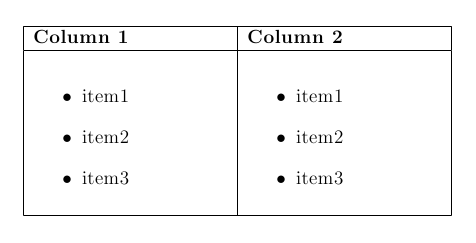

Use the command \ref gives an example of how to write a table in Latex.Generating the PDF should produce thefollowing table. It is a Latex convention to start table references by “tab:”, which no only lets you use the same name for a figure (starting with fig:) and a table, but makes it easier to distinguish between figures and tables. The label is used for reference in the text. In LaTeX, & is what we call an active character. Inside the environnment, each column is separated by &. Its first argument contains what we call a preamble which contains a definition of each column. Caption is the explanation displayed below or above the table, depending on where you insert it, before or after the tabular. A basic table is built with a tabular environment.

H (here), t (top), b (bottom) and p (page of floats).Ĭaption and label are the same commands used when including figures.


There is an optional argument which determines where Latex places the table. There are two ways in LATEX to create a table : ( 1 ) use the tabbing environment and ( 2 ) use the. The number of columns does not need to be. The macro provided by LED is the following code: A table environment doesn't itself create a table. The table spec argument tells LaTeX the alignment to be used in each column and the vertical lines to insert. Most of the Latex editors provide a macro, which is usually helpful as it directly inserts the basic stub usually including a few rows and columns of the table.
Begin tabular latex code#
Outputting the Latex code is equally easy: print(‘\nTabulate Latex:’) print(tabulate(rows, headers=’firstrow’, tablefmt=’latex’)) print(‘\nTexttable Latex:’) print(latextable.draw_latex(table, caption=”A comparison of rocket features.Let me start with the table-stub and later on explain how to fill in the actual table content. For a list of rows containing your table data, the tables are created as such: print('Tabulate Table:') print(tabulate(rows, headers='firstrow')) table = Texttable() t_cols_align( * 4) t_deco(Texttable.HEADER | Texttable.VLINES) print('\nTexttable Table:') print(table.draw()) Using either library is incredibly straightforward they both do exactly what they’re designed for and have pretty similar usages. It provides a similar output to the tabulate Latex format, as well as providing extra functionality such as matching the formatting of the texttable console output and allowing the user to add table captions and labels. I creatively called it latextable, and it’s currently available on PyPi. However, as a personal side project, I put together my first Python library that acts as a wrapper around texttable to create Latex tables. Texttable, being more lightweight than tabulate, offers no such solution. One of these formats allows the creation of latex code, providing you with text that you can directly copy and paste into your Latex document. The tabulate formats are mostly geared towards use in other platforms or to emulate their designs, e.g. In all likelihood, I use it because it was the first library that I came across for creating tables, but it hasn’t let me down yet. My personal preference is to use texttable. Tabulate chooses to focus instead on pre-designed formats, but the user is still able to override these if they choose to do so. Texttable gives complete autonomy to the user in terms of choosing their table design it’s possible to customise column alignment, header alignment, table decoration, column types and even the characters used to draw the lines between the rows and columns. A comparison of the downloads for tabulate and texttable ( PyPi Stats )īoth libraries allow you to format the tables in a particular style.


 0 kommentar(er)
0 kommentar(er)
